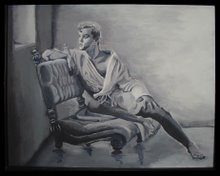
Ganges has been laying around the house for a couple of years now. I postponed having him framed because I knew it would be expensive. Larger works cost more to frame, and let's face it, Ganges is a big ol' boy. This work is actually 16"X20". After matting the frame was a good size.
What was the inspiration for this drawing of Ganges? Let's go back a bit and review. A few years ago I read Dan Brown's "Angels and Demons". In my opinion its a better read than "DaVinci Code". It didn't get as much attention because the story isn't as controversial and scandalous. But, its a much more exciting and adventurous tale. Just as the works of DaVinci were the star of "Code", the art of the sculptor Bernini was featured in "Angels". The basic premise is that Bernini's many angel sculptures that are sprinkled all over Rome help our hero, Robert Langdon, solve the murders being comitted by a serial killer.
One of the most exciting scenes involves a fight to the death between Langdon and the villain in the Fountain of the Four Rivers. Bernini sculpted four anthropomorphic male figures to represent the major river of each of the four continents known to Europe at that time. There is the Nile to represent Africa, the Danube to represent Europe, the Rio da Platta for the Americas and Ganges to represent Asia. These four figures support an Egyptian obelisk that is crowned by a dove. The Post-Reformation symbolism meant that the power of the church (dove symbol) triumphs over every continent in the world (the male river figures). Each of the male figures holds another symbol to help identify him and attach him to his associated river. For instance, the head of the Nile was unknown at that time so the male figure has a cloak pulled over his head and hides his face. The American figure shows non-European features (some suggest it is a native American figure, others say it has Negro features) and includes piles of coins around him to represent the riches of the New World. Ganges is holding an oar to represent that river as a major transportation and trade route through Asia.
I chose to paint Ganges simply because the photo reference I had showed great compositional elements. There are two strong diagonal lines in the work. The reclined body and legs move upper left to lower right and the direction of the oar crosses the opposite direction. The two lines intersect at the center of the mid-point of the work. The right leg of the figure is extremely foreshortened and almost thrusts out of the picture plane. I thought this was a great artistic challenge for me and enjoyed working on the drawing.
I originally planned to do more finishing work on this drawing. But, I started having artistic arguments with myself. I often get too fussy and picky with my works. I sweat over every detail. I started adding the classical columns in the background, then I worked more on the stone. So I asked myself. What is the main focus of this drawing? Well, its the very dynamic pose and action of this beautiful classical figure, of course. So, I realized that if I kept scratching and smudging around on the other stuff in the drawing that I would just distract from the central theme. So, I saw that I had pretty much completed the figure. So, I followed Maestro DaVinci's saying, "... a painting is never completed, merely abandoned." So I stopped and put him away.
I hope everyone enjoys this piece as much as I enjoyed making it. Some of my friends have already perceived Ganges' oar as a phallic symbol and have given me quite a bit of harassment about that. Personally, I never even saw it that way until some of them pointed it out. So, I suggest that they may be reading too much into it. They should remember that sometimes an "oar is just and oar."


2 comments:
Thanks for the information!!!
Post a Comment